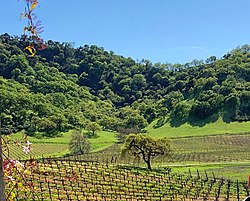| Wine region | |
 Vineyard in Morgan Hill, California | |
| Type | American Viticultural Area |
|---|---|
| Year established | 1989[1] |
| Years of wine industry | 247[2] |
| Country | United States |
| Part of | California, Central Coast AVA, San Francisco Bay AVA |
| Sub-regions | Pacheco Pass AVA, San Ysidro District AVA |
| Precipitation (annual average) | 16 to 20 in (406–508 mm)[1] |
| Soil conditions | Yolo and Zamora-Arbuckle-Pleasanton Associations[1] |
| Total area | 352,000 acres (550 sq mi)[1] |
| Size of planted vineyards | around 1,500 acres (607 ha)[1][3] |
| Grapes produced | Cabernet Sauvignon, Carignane, Chardonnay, Fiano, Grenache, Grignolino, Merlot, Muscat Canelli, Petite Sirah, Pinot noir, Riesling, Roussanne, Sangiovese, Semillon, Syrah, Zinfandel[4] |
| No. of wineries | 40+[1] |
Santa Clara Valley is an American Viticultural Area (AVA) located mostly in Santa Clara County, California. The area served an important role in the early history of California wine and was home to the pioneer winemakers Paul Masson and Charles Lefranc. It was established on April 27, 1989 by the Bureau of Alcohol, Tobacco and Firearms (ATF), Treasury after evaluating the petition proposing a viticultural area in Santa Clara, San Benito, San Mateo and Alameda Counties that extends from lower San Francisco Bay with the cities of San Jose, Santa Clara, Menlo Park, Mountain View and Fremont toward the southern boundary near Gilroy and Morgan Hill, outlining the viticultural area named "Santa Clara Valley." It includes the historic winegrowing areas of Santa Clara County not already within the [Santa Cruz Mountains viticultural area, plus the area near Mission San José in Alameda County and a small part of San Benito County. Santa Clara Valley encompasses the established viticultural areas, Pacheco Pass and San Ysidro District.[5]
- ^ a b c d e f "Santa Clara Valley Viticultural Area, CA" (27 CFR Part 9 [T.D. ATF-286; Re: Notice No. 653] Final Rule). Federal Register. 54 (58). Bureau of Alcohol, Tobacco and Firearms (ATF), Treasury: 12603–12607. March 28, 1989.
 This article incorporates text from this source, which is in the public domain.
This article incorporates text from this source, which is in the public domain.
- ^ Cite error: The named reference
Adams_325was invoked but never defined (see the help page). - ^ "USDA National Agricultural Statistics Service" (PDF). 2011.
- ^ "Santa Clara Valley (AVA): Appellation Profile". Appellation America. 2007. Archived from the original on February 22, 2009. Retrieved March 25, 2015.
- ^ Robinson, Jancis, ed. (2006). The Oxford Companion to Wine (3rd ed.). Oxford University Press. pp. 608. ISBN 978-0198609902.
